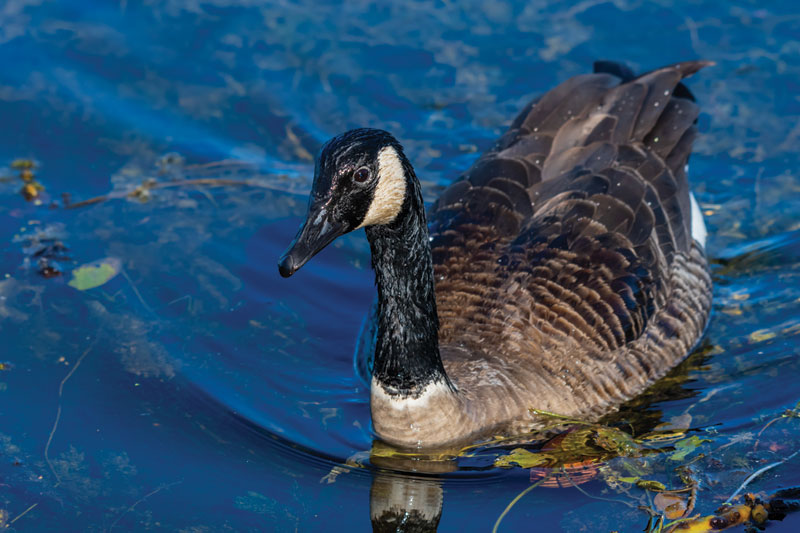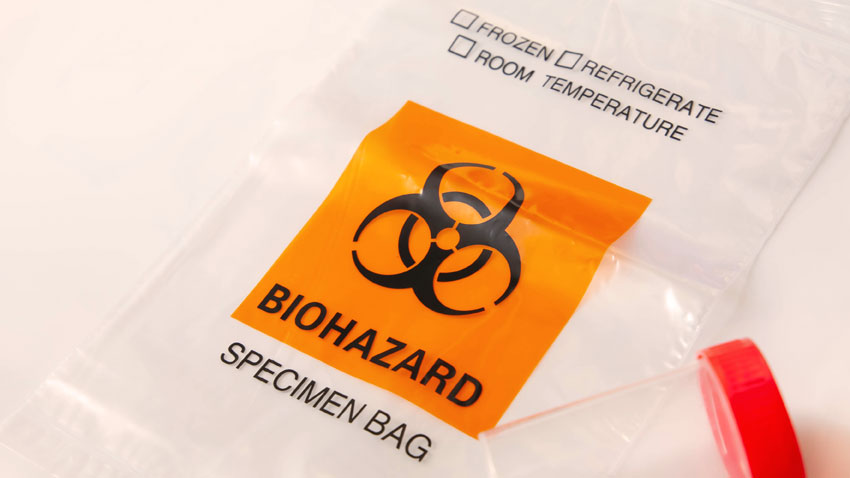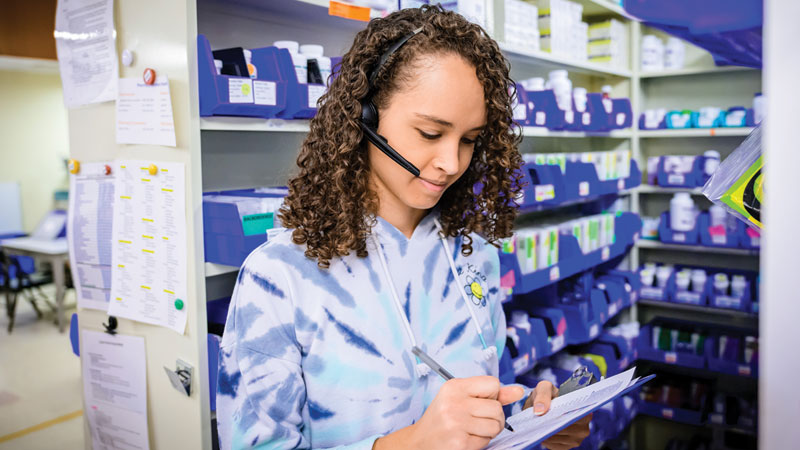Best Practices for Vet Practices
This list of recommendations was compiled in March of 2020 by Dr. Ashley Mitek from information provided by the Illinois State Veterinary Medical Association, the Illinois Department of Public Health and Department of Agriculture, and Dr. Jim Lowe of the University of Illinois College of Veterinary Medicine; it was last updated by Dr. Mitek with input from Dr. Will Sander on August 31, 2021.
General Advice for Veterinary Practices During the COVID-19 Outbreak
- For general questions, call the state’s COVID-19 Hotline: 1-800-889-3931, email:SICK@ILLINOIS.GOV or visit the Illinois Department of Public Health coronavirus webpage.
- Make sure you have the numbers handy in case you need to consult with them.
- Institute appropriate cleaning and disinfection of communal surfaces. A list of Environmental Protection Agency (EPA) certified products but always pay attention to contact time.
- Encourage staff hygiene (frequent handwashing).
- Prohibit sick or febrile staff from working in your clinic. Staff members with symptoms of COVID-19 should self-quarantine and not be allowed to work for 14 days.
- Likewise, if a staff member has traveled to an area with widespread transmission, consult with your local health department about any restrictions on the person returning to work.
- It is recommended that people infected with COVID-19 avoid contact with their pets, including petting, snuggling, being kissed or licked and sharing food. Another person in the household should feed and care for the pet. If the ill person must provide the care, the person should wear a mask and wash hands before and after interacting with the pet.
- As a reminder, at this time, the U.S. Centers for Disease Control and Prevention (CDC) and the World Health Organization (WHO) say there is no evidence and low risk that companion animals, including pets, can spread COVID-19. However, as with any disease, it’s always a good idea to wash your hands after being around animals.
Ivermectin Alert for Veterinarians
Why have the Centers for Disease Control and Prevention and the Food and Drug Administration (FDA)’s Center for Veterinary Medicine issued a health alert regarding ivermectin prescriptions?
Ivermectin dispensing by retail pharmacies has drastically increased. Veterinary formulations, that are not intended for human use, are being purchased over the counter by the general public. The FDA has listed several potential risks of using ivermectin in this way.
Does this health alert change the way veterinarians prescribe ivermectin?
Yes. The Illinois Department of Public Health recommends that all veterinarians in the state do the following when prescribing ivermectin:
- Tell the client NOT to give the drug to humans
- Consider distributing an educational statement with all ivermectin prescriptions. Here is sample language provided by IDPH:
- Per a Centers for Disease Control and Prevention Health Alert: Ivermectin is not authorized or approved by FDA for prevention or treatment of COVID-19. The National Institutes of Health’s (NIH) COVID-19 Treatment Guidelines Panel has also determined that there are currently insufficient data to recommend ivermectin for treatment of COVID-19. Adverse effects associated with ivermectin misuse and overdose are increasing, as shown by a rise in calls to poison control centers reporting overdoses and more people experiencing adverse effects.
- https://www.fda.gov/animal-veterinary/product-safety-information/faq-covid-19-and-ivermectin-intended-animals
What should I do if I am now having a hard time acquiring ivermectin for my veterinary patients?
The FDA asks that you report any of these concerns to: AnimalDrugShortages@fda.hhs.gov
What should I do if I see any animal drug advertising promoting ivermectin for the treatment of COVID-19?
The FDA asks that you email them with any of these concerns: FDA-COVID-19-Fraudulent-Products@fda.hhs.gov or call 1-888-InfoFDA (1-888-463-6332).
Advice on Delivering Veterinary Care During the COVID-19 Outbreak
- Triage or treat as many cases as possible by telemedicine (e.g., using FaceTime or Skype). Note: telemedicine presumes an existing veterinary-client-patient relationship, i.e., it is appropriate only for a client/patient you have previously seen in person. AVMA has developed guidance including a triage toolkit and state by state listings of orders in place available on their COVID-19 page.
- All hospital staff should wear a facemask and practice social distancing when possible. We encourage practices to minimize or prevent pet owners from entering the practice. Instead, staff can bring animals in and out of the hospital from the owner’s car.
- Nothing should move from an infected/quarantined household to a clinic without appropriate planning (what, who and how you would see the case).
- If a client has a fever, cough, sore throat, or possible exposure to COVID-19, arrange for someone else to bring the sick animal to the clinic or use telemedicine for an evaluation of the animal.
- Contact the local health department for advice on how to safely deliver veterinary care to the animal.
Additional Resources
- AVMA COVID-19 Resources
- IL State Veterinary Medical Association COVID-19 Resources
- AVMA recommendations on Keeping Your Staff Health, Caring for Veterinary Patients, and the use of Telemedicine
- FAQs on Surgical Mask Shortage
- Interim Infection Prevention and Control Guidance for Veterinary Clinics Treating Companion Animals During the COVID-19 Response
FAQs on Whether Veterinary Practices Should Remain Open
Are primary care veterinarians “essential”? Should veterinary practices close if cities announce a Shelter-in-Place order?
Human health and safety must remain the priority in this pandemic. The COVID-19 virus appears to have high transmission rates, and shedding of the virus appears to occur before the infected person develops symptoms.
For that reason, we encourage all veterinary clinics to consider going emergency only and heavily utilize telemedicine if a shelter in place order is announced in their jurisdiction.
Are pet boarding facilities allowed to remain open?
We recommend that if you chose to keep your boarding facility open, you minimize any human-human interaction, and pick-up and drop-off pets curbside, so pet owners do not enter the facility. Common surfaces should be frequently sanitized.
If your practice is in a jurisdiction that has issued a Shelter-in-Place order, we strongly encourage you to close your boarding facility.
What about doggie daycare?
If you operate a doggie day care facility, we encourage you to do curb-side drop-off and pick-ups, to minimize the number of people entering the facility, as well as minimize any risk of human-human interaction. Common surfaces should be frequently sanitized.
If your daycare is in a jurisdiction that has issued a Shelter-in-Place order, we strongly encourage you to close your facility.
FAQs for Veterinary Practices That Are Seeing Patients
Are rabies vaccines considered an emergency or urgent medical need for which a dog or cat should be seen?
The Illinois Department of Agriculture released guidance that says rabies vaccination should still be administered when possible, but priority should be placed on animals getting their first rabies vaccination or their first booster rabies vaccination. For those animals coming due for a booster, the guidance says to give it if possible but it can be postponed if necessary. The Department of Agriculture and the Department of Public Health are currently having conversations about an agreement to provide flexibility in due dates for vaccinations from a legal standpoint.
We do know that rabies titers in dogs typically last much longer than the three-year booster requirement for rabies.
Is there a specific way our practice should dispose of PPE equipment after interacting with patients?
There are no additional precautions when doffing PPE other than to ensure you wash your hands immediately before touching your face or the rest of your body. Double bagging is not needed.
For additional information, see guidance released by CDC and OSHA.
Should all practices adopt a curb-side model where patients are picked up from the owner’s car?
Yes. The AVMA strongly encourages veterinary clinics to go to a curb-side model where patients are picked up from the owner’s car and then history, etc., is taken by telephone.
The exception to this recommendation may be for euthanasia, but then proper social distancing should be followed, if at all possible.
This protocol can also be followed on ambulatory large animal calls in many cases where the owner can have the animal secured ready to be examined before the veterinarian gets there. Once arriving on the farm, the veterinarian can call the owner to talk about the case and examine the animal, assuming the veterinarian can conduct the exam safely without assistance.
How do I disinfect cages or other surfaces if a dog from a suspected COVID-19—positive household came in contact with them?
There are a number of disinfectants that the EPA has noted as effective. The full list can be found here: https://www.epa.gov/pesticide-registration/list-n-disinfectants-use-against-sars-cov-2
Veterinarians can look up the EPA registration number on the MSDS reference sheet for any disinfectant they have in their practice.
Please remember to abide by the manufacturer’s recommended contact time.
What are the recommendations for interacting with pets in the home of a suspected COVID-19—positive household?
The CDC has released the following interim guidelines for managing people in home care with COVID-19 or suspected infection: https://www.cdc.gov/coronavirus/2019-ncov/php/interim-guidance-managing-people-in-home-care-and-isolation-who-have-pets.html
The overall guidance would be that the client who has or suspected to have COVID should wear a facemask. It is recommended that the veterinarian should also wear gloves and a facemask as well. The AVMA has also released additional guidance about mobile appointments that include assessing the client over the phone first to see if they are sick or possible exposure to COVID-19 and postponing all elective or preventive procedures for home visits, especially if there is a high risk the client has COVID-19.
If you still must do the mobile visit, we recommend doing as much of it as possible outside and ideally having a different household member with the pet (https://www.avma.org/resources-tools/animal-health-and-welfare/covid-19/mobile-house-call-veterinarians-covid19-pandemic)
How do I handle staff who may be sick or be positive for COVID-19?
Employees should be instructed to notify their manager if they have been exposed to or diagnosed with COVID-19, have been within close proximity of someone who has been diagnosed with COVID-19, or experiencing symptoms (fever, cough, shortness of breath, breathing difficulties, loss of taste or smell). Any disclosure to a manager should be kept in confidence as required by the Health Insurance Portability and Accountability Act.
Staff should be notified of a possible exposure or diagnosis but the affected employee’s name should not be shared.
A risk-based approach should always be considered in evaluating whether staff should continue working with a possible exposure. Local and state health departments should be consulted whenever possible regarding managing staffing concerns in relation to COVID-19. Several resources have been developed both by AVMA and CDC to guide veterinarians in handling staff and potential exposures.
If staff test positive for COVID-19, they should self-quarantine for 14 days. If staff is considered a critical infrastructure worker and is asymptomatic, whether COVID-19 positive or exposed to a COVID-19 positive person, CDC developed guidance of additional precautions they can take if they cannot self-quarantine.
FAQs Regarding Vaccination Information
When will veterinarians and veterinary support staff be able to get the vaccine?
Most veterinarians and veterinary care staff are now eligible for vaccination. Please reach out to your local public health office for updated information.
Is the vaccine safe?
The below message is an update from one of our public health experts, Dr. Will Sander, that was sent to all College of Veterinary Medicine faculty, students and staff on January 25, 2021:
There have been many questions about the safety, efficacy, and prioritization of vaccines for COVID-19.
This is likely the fastest a new vaccine has been rolled out to the general public. These mRNA vaccines are built on decades of research with advancements achieved over time. This is the biggest roll out of a mRNA vaccine. I do not doubt the safety/efficacy of the studies to date and there will always be more information gained when they are rolled out to millions of individuals.
Some key points:
- This vaccine cannot cause infection with SARS CoV-2. It provides the blueprint for your cells to make the spike protein that mimics that of the virus.
- There’s minimal data on how long immunity lasts from the vaccine simply because the studies could not go long enough to assess but we do know it reduces severity of clinical signs.
- These vaccines are overwhelmingly safe and should only be avoided if you have had previous anaphylactic reactions to vaccinations. You should always consult with your health care provider.
Additional resources are below:
- https://www.cdc.gov/vaccines/hcp/acip-recs/vacc-specific/covid-19.html
- https://www.avma.org/resources-tools/animal-health-and-welfare/covid-19/covid-19-vaccines-and-vaccination
- https://emergency.cdc.gov/coca/calls/2020/callinfo_121820.asp
- https://www.cdc.gov/coronavirus/2019-ncov/vaccines/faq.html
Veterinarians are considered to be in tier 1B by the state.
FAQs on Mink-Human Transmission
These questions reflect recent data related to mink-human transmission of the coronavirus
Can people transmit SARS CoV-2 to animals?
Yes. Although this occurrence is rare, it is possible for people to infect animals, including their pets, with SARS CoV-2, the virus that causes COVID-19. Here is what we know so far.
The Centers for Disease Control and Prevention (CDC) reports that, among pets like dogs and cats, a small number worldwide have been reported to be infected. This has occurred mostly after close contact with people who were infected with SARS CoV-2.
For this reason, it is recommended that if a person inside a household becomes sick or tests positive for SARS CoV-2, they should isolate themselves from other people as well as other pets. In addition, pets living in a household with an infected person should not socialize with anyone or any animals outside of that household.
One recent study that has not been published or peer-reviewed has shown that dogs, cats, and ferrets living in households with humans that have been positive for SARS CoV-2 do seroconvert. Seroconversion means that the pets developed antibodies to the virus, indicating that they were previously exposed and infected.
For more information please visit: https://www.cdc.gov/coronavirus/2019-ncov/daily-life-coping/pets.html
Do pets or other animals get sick from SARS-CoV-2 like people do?
This answer depends on the species. According to the World Organisation for Animal Health, cats, mink, and dogs have all tested positive for the virus after exposure to a human with known or suspected SARS-CoV-2. Cats and mink are most likely to become symptomatic, when compared to dogs, and mink appear to have an increased likelihood of dying.
In experimental studies, cats are able to transmit the infection to other cats, and can become symptomatic. We also know that according to recent outbreaks on mink farms, mink can transmit the virus to other mink, and in rare circumstances, infected mink can transmit the virus to humans.
On October 9, 2020, the Wisconsin Dept. of Agriculture confirmed that at least 2,000 mink have died from the coronavirus at a Wisconsin mink farm. The Centers for Disease Control and Prevention have deployed a team to the scene to make sure the outbreak is controlled. For more information on the WI outbreak please visit: https://www.wisn.com/article/coronavirus-hundreds-of-mink-die-at-wisconsin-farm/34317985
For more information, please visit: https://www.oie.int/en/scientific-expertise/specific-information-and-recommendations/questions-and-answers-on-2019novel-coronavirus/
To view an updated list of species that have had confirmed infections with SARS-CoV-2, please visit: https://www.aphis.usda.gov/aphis/ourfocus/animalhealth/sa_one_health/sars-cov-2-animals-us
Can pets or other animals transmit the new coronavirus to people?
The current COVID-19 pandemic is clearly driven by human-to-human spread of of the coronavirus.
Although the exact origins of the pandemic are unknown, it is likely that the virus initially jumped from an animal species to a human, and then human-to-human spread became the primary mechanism of transmission.
The CDC notes that “based on the limited information available to date, the risk of animals spreading COVID-19 to people is considered to be low.” There are no documented cases of dogs or cats spreading the virus to people.
The one species where there is evidence of transmission occurring is in mink. A Dutch team of veterinary scientists used whole genome sequencing to identify the source of COVID-19 transmission. Sixteen mink farms were included in the study, including 97 workers at the farms tested. Approximately two thirds (67%) of workers showed evidence of SARS-CoV-2 infection (66/97 employees). After evaluating evidence from genetic testing, researchers in this study strongly suspect that at least some of the humans were directly infected by mink, although they note that additional research is needed in this area.
Mink continue to be a species experts are closely watching. In August 2020, the USDA announced that two mink farms in Utah had been affected by SARS-CoV-2. At this time, authorities report that no humans connected to those farms had been infected.
The CDC does remind everyone that there is no evidence that the virus can spread to people from the skin, fur, or hair of pets. Guidance does not recommend bathing pets or other animals even if the animal is exposed to the virus because it appears the virus cannot survive for long periods of time on this surface.
However, they do recommend that since animals can spread other diseases to people, it’s always a good idea to practice healthy habits around pets and other animals, such as washing your hands and maintaining good hygiene.
For more information on this topic please visit the CDC’s website.

![[dog on exam table]](https://vetmed.illinois.edu/wp-content/uploads/2021/04/covid19-vet-practices.jpg)


